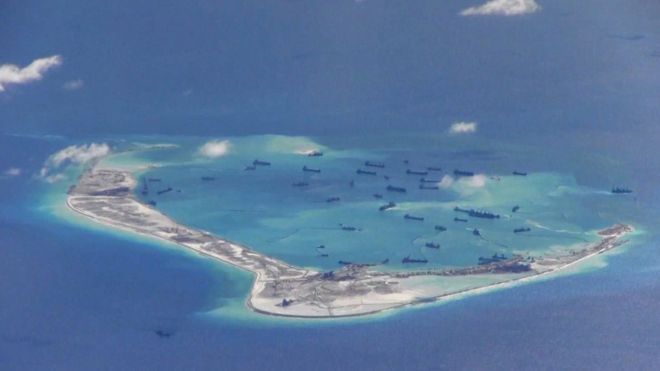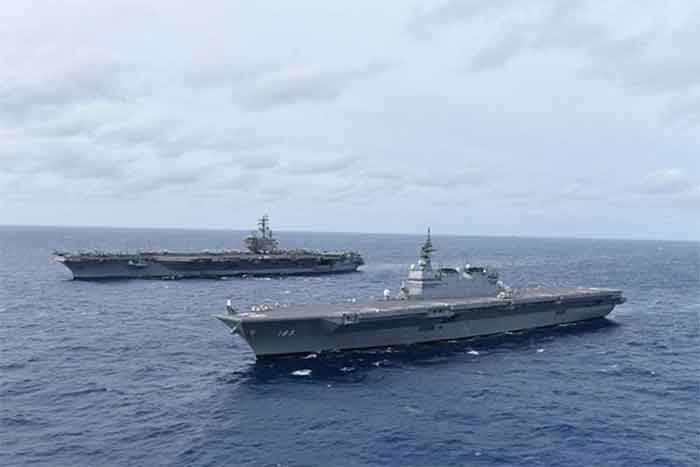
For USA the major foreign policy challenge after the problem of terrorism is South China Sea where China has become quite assertive with open show of the intimidation to the neighbourng states and the world community at large particularly after The Hague Tribunal decision.
USA has been placed in a very precarious and diplomatically sensitive position if it confronts the China the danger of emergence of a more serious tensions leading in all probability to the war may take place, the other option is to remain silent in full manner. The dilemma with US is how to deal the Chinese assertion not only in this zone of conflict but at the larger scale. After the end of the cold war, first time US is forced to deal any power which shows assertive behaviour. The Chinese objectives are dangerous and the historical lessons suggest that China can go to any extent to save its self interests howsoever they are illegal.
In the Vientiane, Laos the ASEAN Foreign Ministers meeting was crucial in the sense that it was the first meet after the declaration of the Hague Tribunal that Chinese claim was incorrect on the South China Sea. Several adjoining counties of the South China Sea are also the member of the ASEAN, hence ASEAN’s approach to the South China Sea was very important but it failed to castigate the China due to internal strife among the members. Cambodia is the main supporter of China in the group. Since last four years it has supported China on this issue, it was Cambodia’s insistence that China need not to be criticized on the problem though Philippians and Vietnam are main opponent of China but the impact of Tribunal’s decision was of not of the consequence due to supportive stand taken by Cambodia which China has acknowledged. USA although wanted that in joint statement, Tribunal’s reference be made but China and its allies in ASEAN thwarted US attempts. The joint statement of the Foreign Ministers of the ASEAN just reiterated ‘to ensure that Southeast Asia and its surroundings remain a peaceful, stable and secure region; and to promote mutually beneficial relations to maintain peace, security and stability, and prosperity with nations in the region and the global community of nations’; the weak statement suggest that within ASEAN the conflicts with respect to South Chinas do exist moreover the ASEAN has decided not to take very strong view as a group against Chinese assertion on the South China sea. In this background US Foreign Minister Kerry’s visit to the Laos and the diplomatic activities undertaken unveiled though in hidden way its new South China policy which rests upon the following premises:
US wants not to come in direct confrontation with China. It has down played the Chinese activities in the recent time, it seems to have realized that this is not a proper time to proliferate the Chinese aggressiveness.
To develop an alliance system as it stresses the cooperation among the US, Japan, Australia for the region but simultaneously not to provoke China. US has always worked for the alliance system. The establishment of the SEATO for the region evidences it.
US has also emphasized the role of the ASEAN which can be used as an economic tool for the region. It knows that ASEAN in spite of close collaboration among the states stand nowhere against Chinese might but the group may be of use in economic terms for dealing the China.
The US and Chinese relationships will largely be governed by the US response to the Chinese threats. China has adopted an aggressive policy on the issue and US has decided for time being to remain non aggressive and to avoid provocation of China. This is only a transient policy as US knows well that South China Sea in near future may turn into a theatre of sharp conflict due to damage likely to be inflicted upon its associates in the region hence any silence cannot be perpetual. This understanding of USA is consistent to the ASEAN policy which in the 15th East Asia Summit, November 2015 had decided to play down the role of China in South China Sea. The Chairman of the East Asia summit had ‘welcomed the assurances given by China as expressed by President Xi Jinping during his visit to the United States of America recently that China does not intend to pursue militarisation in the South China Sea. (and) the commitment of ASEAN Member States and China to ensure the full and effective implementation of the Declaration on the Conduct of Parties in the South China Sea (DOC) in its entirety: to build, maintain and enhance mutual trust and confidence; to exercise self-restraint in the conduct of activities; not to resort to the threat or use of force; and for the states concerned to resolve their differences and disputes through peaceful means, in accordance with international law including the 1982 United Nations Convention on the Law of the Sea.’ This statement was issued almost eight months ago but after the Hague Tribunal decision the new situations have been created where China has now decided to become more assertive and ASEAN has gone into disarray with no consensus about the coercive role of China in the South China Sea but US has cleverly crafted its policy not to confront the China immediately. The US-ASEAN approach and US-East allies (South Korea, Japan, and Australia) approach is to follow a non provocation policy for some time with enhancement in strength in the region with allies.
Non provocation policy may be altered any time and may take a confrontationist form. The US new policy appears to be a diplomatic move to prepare for the worst. The way China and US with its allies are focused on the South China Sea, suggest that war like situations may be created in near future; the need therefore is of high quality diplomacy to contain the proliferation of the conflict.
Dr. Vivek Kumar Srivastava is Vice Chairman CSSP, Consultant CRIEPS, e [email protected]















































